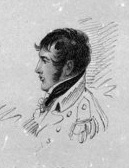Hood’s Boys
30 June 2022John Donaldson Boswall
30 June 2022
George Bettesworth was the second son of John Bettesworth of Carhayes, Cornwall. In October 1807, his cousin, Lord Byron, wrote:
Next January … I am going to sea for four or five months with my cousin, Captain Bettesworth, who commands the Tartar, the finest frigate in the navy … We are going probably to the Mediterranean or to the West Indies, or to the devil; and if there is a possibility of taking me to the latter, Bettesworth will do it, for her has received four-and-twenty wounds in different places, and at this moment possesses a letter from the late Lord Nelson stating that Bettesworth is the only officer in the navy who had more wounds than himself.
Dictionary of National Biography 1885-1910 Vol 04
Lord Byron’s family connection was through his grandmother, Sophie Trevanion who came from an old Cornish family.
The anecdote about George Bettesworth’s injuries is borne out by some of the reports we have published here notably the taking of the Curieux and the Dame Ernouf when he received a musket ball to the head.
Born in 17802
Another anecdote of his time on the Curieux reports that he ‘one day took her jolly boat in shore, together with the purser, who played the violin. A local black [man] came out of the undergrowth on shore and held up a pair of fowl, indicating that he sought to sell them. Bettesworth took the bait and had his men row to the shore. The moment the boat touched the beach, a squadron of cavalry burst from the undergrowth. Their gunfire wounded Bettesworth3 in the thigh, causing substantial loss of blood, and broke the coxswain’s arm. At Bettesworth’s urging, the crew of the boat got it off the beach and rowed back to the Curieux. On the way back Bettesworth wanted to open a bottle of champagne, but the purser broke it in his nervousness.’ One rather suspects the last sentence.
Then, of course, he was trusted with Nelson’s vital despatch about Villeneuve’s Combined Fleet and manged to drive the ship fast enough to over-take the fleet and reach home waters in time. For this he was immediately appoint Post.
He was then appointed to HMS Crocodile, 22, serving off France and in Halifax Nova Scotia before transferring to HMS Tartar, 32, in October 1807.
On Sunday the Tartar frigate, of 32 guns, and the Ariadne, of 20 guns, arrived in Leith Roads from Sheerness. The Tartar, we understand, proceeds immediately to her station off North Bergen [a reputed haunt of smugglers], as there may be dome dashing service in that quarter, we doubt not Captain Bettersworth [sic] will display equal gallantry whit that he has already shewn on former occasions.
His Majesty’s ship Erebus, is arrived at Greenock, and is to be followed by the Thais, both ordered there for protection of the trade.
Caledonian Mercury, May 12th, 1808
In May 1808 he was engaged at Alvoen off Bergen and, attempting to cut-out some vessels, the Tartar became becalmed and was attacked by gunboats. Sadly George was killed in the first salvo. He was probably only 28 years old and had packed quite a variety of experiences into his short life.
He was buried in the Howick, Northumberland.
- Accounts vary between 1780 and 1785. He must have been at least 20 when he was promoted Lieutenant on HMS Centaur in 1804. As he was made Captain shortly thereafter, we suspect that the 1780 date is more likely[/efn_not] Geogre served as a Midshipman on HMS Phoebe and would have been present when she captured the French Nereide, 36, in December 1797 and the Africaine, 38 in 1801.
At some point he transferred to the Blanche for an anecdote recounts:
RECENT GALLANT EXPLOIT. – The Blanche frigate, Captain Mudge, cruizing on the coast of France, took a small fishing-boat, which at the suggestion of Mr. Fromow, first Lieutenant, was fitted up as a gun-boat, with a 12lb. carronade, of which Mr. Fromow took the command, and had to make up his crew, Mr. Lockyer, master’s mate, Mr. Bettesworth, midshipman, four seamen, and four marines. They entered the harbour of Havre, and came to anchor about five in the morning; a sloop, deeply laden, was about to enter; they attacked, and carried her. Mr. Bettesworth and two men were placed on board her, and directed to proceed to the Blanche, at a distance in the offing; but the transaction being observed by the people of Havre, a brig, mounting 16 guns, which lay in the harbour, slipped and chaced the boat, and getting within pistol shot opened a heavy fire of grape shot, by which the boat was much shattered; her gallant little crew, however, kept up a brisk fire with their carronade, beat in the brig’s quarter, and the Blanche making towards the harbour, the brig sheered off, and the prize was secured, without any of the British receiving a wound. – They then made a present of the boat to the fishermen from whom she was taken.
Salisbury and Winchester Journal June 27th 1803In January 1804 he transferred to HMS Centaur in the West Indies and he participated in cutting-out the Curieux. George was appointed to be Captain of the St Lucia cutter but when Robert Reynolds was unable to take full command of the Curieux because of his injuries, George was appointed captain. He does not seem to have taken up his appointment immediately, certainly he was not on board for the Queen Charlotte Incident on 14th September.
By the Barbadoes Papers to the 9th of August, we have received the following account of a naval action on the West India station. –
His Majesty’s schooner St. Lucia, Capt, Bettesworth, arrived last night from Antigua …
Morning Post, October 15th, 1804By the end of September, however, he was in command of the Curieux1National Archives ADM 36/17054
- Again!
